1921: The "ancient tribe" of the "Smoki Indians" is BORN (see what I did there...)
By 1920, the Hopi Nation Snake Dance was pretty famous. It's popularity had swelled to thousands over (around) twenty years of allowing non-Indians to view the sacred ceremony.
Kate T. Cory (painter and photographer) who lived in Prescott, Arizona in 1913, exhibited her paintings, which drew considerable interest. She had lived with the Hopi much of 1905 to 1012, learning their language, customs, and secret life practices. She took about 600 photographs, recording everyday everything, including their sacred ceremonies. Her photos illustrated her essays about the Hopi's, and in 1915 the Smithsonian Institution bought 25 of her paintings.
Prescott, Arizona had played host to "the Word's Oldest Rodeo " since 1888 . According to the year end report from December, 1914, the total receipts amounted to $12,960.82 (over $320,000 today). Nine hundred people were "attended to" (stayed in hotels). Unfortunately, the town paid out $12,885.81 - leaving a profit of $75.01 ($1,852.) That was put towards the following year.
The 1919 Frontier Day's events included a twenty piece band playing daily concerts, a rodeo, cowboy racing, theatre parties, tributes to men in service, boxing bouts, baseball games, dancing, Government air plane exhibits and civilian airplane rides. But the Frontier Days Association was troubled. They faced "extreme difficulties" which included the purchase of new stock, erecting new corrals, and the additional cost of the customary tax of the government gate receipts. In October, 1919, they were trying various fundraising events - including raffling a new Studebaker car for $1 a ticket ($24,70 today.)
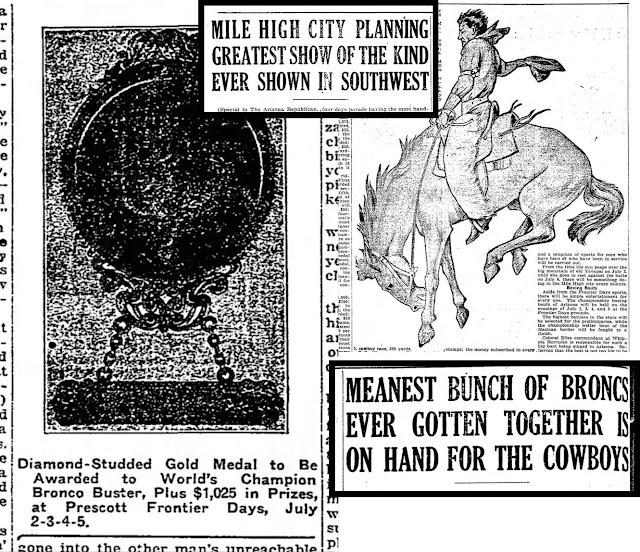 |
| 1919, July 1 Arizona Republic |
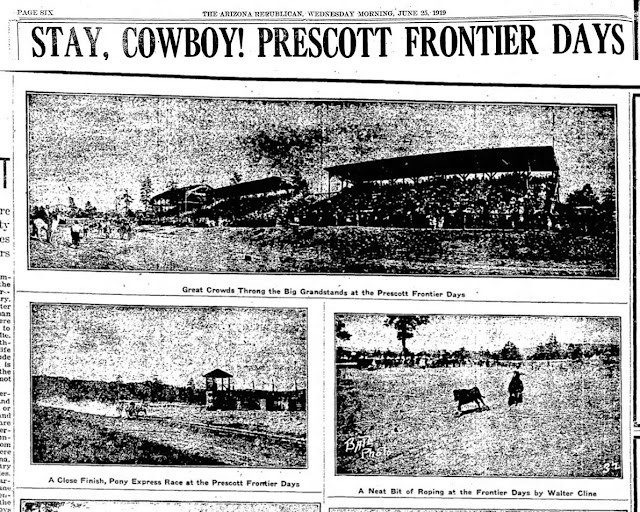 |
| 1919, June 25 Arizona Republic |
In 1920, Prescott expected about 3000 visitors.
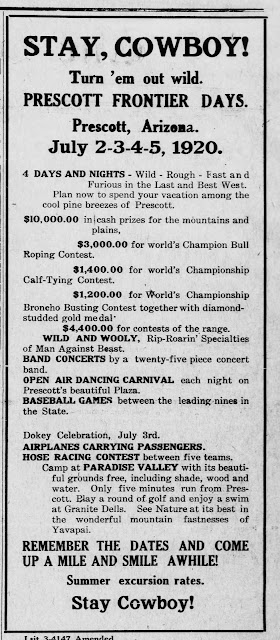 |
| 1920, June 25 William News |
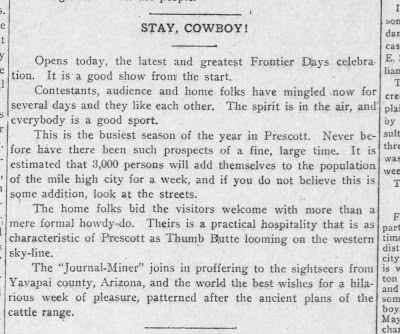 |
| 1920, July 7 Weekly Journal Miner |
In the spring of 1921, Prescott held a "Way out West" was introduced, as a sister to the Frontier Days. There would be a cowboy band, a parade, and the introduction of "Fifty snake priests from the tribe of Smoki" who "will present their famous bull snake dance."
Now, who made this dance "famous?" They said "THEIR FAMOUS" bull snake dance. This is a brand new group - an organization of businessmen, white people, who are saying that this is THEIR dance, and implying that THEY made it FAMOUS. Right off the bat, they are stealing the ceremony that the Hopi was known for - and making up a fictional tribe, claiming that this fictional tribe has previously performed this bull snake dance.
For those of you who don't understand cultural appropriation - THIS IS IT. This is exactly it.
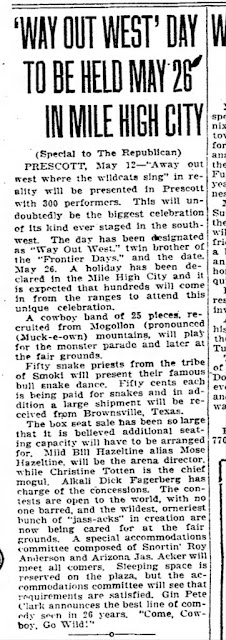 |
| 1921, May 13 Arizona Republic |
The article said that people who say the Indian version of this dance will be surprised.
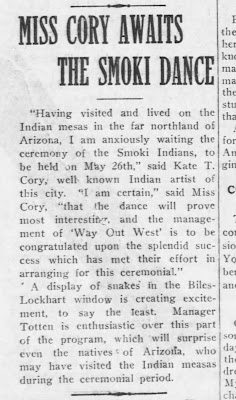 |
| 1921, May 25 Weekly Journal Miner |
Here they say: "The dance of the "Smoki," a production by 30 young men of Prescott of the famous Hopi dance of the snakes, was the feature of the Way Out West celebration.." and that this affair "was held to secure funds to supply purses at the annual Frontier Days.."
"The "Smoki" had been drilled by a woman who lived among the Hopis for a number of years. The costumes, music and movements of the Indians were faithfully reproduced by the Prescott youths, it was said by those who have seen the Hopi ceremony."
"The governor and other prominent men who usually attend the Frontier Days celebration were impersonated in striking fashion."
The Weekly Journal Miner reported on the first Smoki dance in their June 1st, 1921 edition:
"There are palefaces of eastern extraction who could have sat through the Smoki Indian bull-snake dance... never suspecting that the rain-prayer that featured the Way Out West show was not genuine. In a manner of speaking, it was genuine. Great attention had been paid to the details, and to Mrs George Tumbler belongs the honor of having for possibly the first time, reproduced an aboriginal rite with all white performers."
"The secret may as well come out. Not a single Indian in the line of 12 antelope priests, and 12 snake priests, nor the chief, his thunder and high snake priest, the Navajo tomtom player, and finally the five Hopi maidens, was other than a perfectly well known and respected citizen of Prescott or its environs. Everyone except two of the younger maidens can and has voted and they all speak good English."
And then the Smoki Indian Nation of Prescott was born - as was an entire town culturally appropriating - and stealing their profit and tourist dollars - from a small, impoverished Hopi nation who performed this ceremony to bring about rain, as they had for many, many years.
Prescott did it as a fundraiser. And then the Smoki production took on a life of its own.
"The secret may as well come out. Not a single Indian in the line of 12 antelope priests, and 12 snake priests, nor the chief, his thunder and high snake priest, the Navajo tomtom player, and finally the five Hopi maidens, was other than a perfectly well known and respected citizen of Prescott or its environs. Everyone except two of the younger maidens can and has voted and they all speak good English."
 |
| 1921. May 28 Arizona Republic |
Prescott did it as a fundraiser. And then the Smoki production took on a life of its own.
 |
| 1921, June 1 Weekly Journal Miner |



